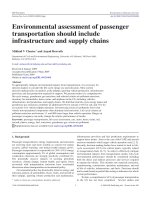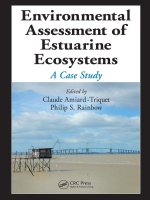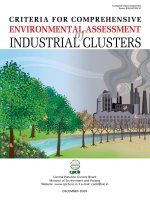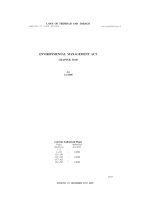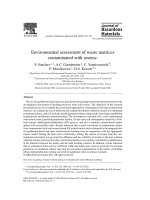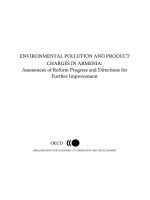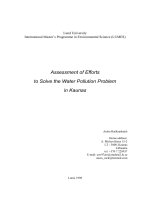Assessment of environmental flow requirement using environmental management classes-flow duration curve for Narmada river
Bạn đang xem bản rút gọn của tài liệu. Xem và tải ngay bản đầy đủ của tài liệu tại đây (318.02 KB, 7 trang )
Int.J.Curr.Microbiol.App.Sci (2019) 8(1): 891-897
International Journal of Current Microbiology and Applied Sciences
ISSN: 2319-7706 Volume 8 Number 01 (2019)
Journal homepage:
Original Research Article
/>
Assessment of Environmental Flow Requirement using Environmental
Management Classes-Flow Duration Curve for Narmada River
Alpna Dubey1*, Omkar Singh2, Shashank Shekhar3 and Chwadaka Pohshna4
1
College of Agricultural Engineering, J.N.K.V.V. Jabalpur (M.P.), India
National Institute of Hydrology, Roorkee-247 667 (Uttarakhand), India
3
College of Agricultural Engineering, Bapatla, (A.P.), India
4
College of Agricultural Engineering and Post-Harvest Technology Ranipool (Sikkim), India
2
*Corresponding author
ABSTRACT
Keywords
Environmental
flow, Riverine
ecosystem, River
basin, Water quality
Article Info
Accepted:
07 December 2018
Available Online:
10 January 2019
The Narmada is the largest west-flowing peninsular river ranks seventh in terms of water
discharge (38km3/yr) in India. A number of dams have been constructed on the Narmada
River and its tributaries, mainly for the purpose of electric power generation, irrigation and
for controlling floods. The objective of this paper is to calculate minimum flow of
Narmada River which is necessary to protect ecosystem and biodiversity at downstream
site of dam which is constructed across Narmada River and its tributaries. In the present
study, the flow data was analyzed for four stations (Sandia, Barman, Dindori, and Manot
gauging stations) in Narmada basin using Global Environmental Flow Calculator (GEFC)
developed by International Water Management Institute (IWMI) Shri Lanka. It is built
around a period-of-record flow duration curve (FDC) accumulative probability distribution
function of flows and includes several subsequent steps. The environmental flow
requirement (EFR) for protection of biodiversity and ecosystem of River minimum flow
should be 46% of MAR (Mean Annual Runoff) at barman station, 45.1% of MAF at
Sandia station and 36.1% at Dindori station and 24.3% of MAR at Manot station of
Narmada basin.
Introduction
Environmental flows are the water that is left
in a river, or released into it (e.g. from a
reservoir), in order to maintain valued features
of the ecosystem (Kingand Tharme, 1993;
Richter et al., 1997). It refers to the water
considered sufficient for protecting the
structure and function of an ecosystem and its
dependent species. This means enough water
is left in rivers, which is managed to ensure
downstream environmental, social and
economic benefits. Environmental flow
requirements are those needed to help
maintain downstream ecosystems, renewable
natural resource production systems and
associated livelihoods (Iyer, 2005). As such,
environmental flow requirement is a
compromise
between
water
resources
development and maintenance of a river in
ecologically acceptable or agreed conditions
(Acreman and Dunbar, 2004). By constructing
dams and weirs and abstracting water, man
tried to exploit the river mainly for
891
Int.J.Curr.Microbiol.App.Sci (2019) 8(1): 891-897
economical purposes. During the middle of
the last century people became aware of the
fact that these interventions in the river flow
regime have important negative ecological and
social effects in the downstream riverine and
coastal areas. The practice of EFR‟s began as
a commitment to ensuring a „minimum flow‟
in the river, often arbitrarily fixed at 10% of
the mean annual runoff (Brinkerhoff, 2000).
But more and more scientific evidence and
experience is available that questions the
„minimum flow‟ approach and there is now a
general opinion that for safeguarding essential
downstream environmental condition the
dynamics of the river flow should be taken
into account. People living along rivers
depend for their livelihood to various degrees
on functions of the river ecosystem and, since
river flow is an important parameter in the
functioning of river ecosystems, these people
are thus affected by changes in the flow
regime. To make equitable decisions in river
basin management insight is required in the
relationship between river flows and the
livelihood of people living along rivers.
Various methods are available for estimating
EFR of rivers and broadly can be grouped
under hydrological index method, hydraulic
rating
methods,
habitat
simulation
methodologies and holistic methodologies
(Richardson, 1986; Tharme, 2003; Smakhtin
and Erivagama, 2008; Dubey et al., 2013). In
the present paper, EFR of few reaches of
Narmada River has been assessed using
Global Environmental Flow Calculator
(GEFC, IWMI).
Materials and Methods
Study area
The Narmada is the largest west-flowing
peninsular river, ranks seventh in terms of
water discharge (38km3/year) and drainage
area (98,796 km2) in Indian subcontinent.
The river rises as groundwater seepage from
Narmada Kund (1057 m above mean sea
level) at Amarkantak on the eastern fringe of
the Maikala Plateau. The Narmada is fed by
41 tributaries, 22 are on the left bank and rest
is on the right bank of the mainstream(CPCB,
2001). A number of dams have been
constructed on the Narmada River and its
tributaries, mainly for the purpose of electric
power generation, irrigation and for
controlling floods.
According to the Narmada Control Authority
(NCA) the river drains an area of 98,796 km2
out of which nearly 86% lies in Madhya
Pradesh, 1% in Chhattisgarh, 2% in
Maharashtra and 11% in Gujarat.
The Narmada basin is dominated by humid
tropical
climate.
Maximum
(average)
temperature is observed during May (40-42
o
C) and minimum (average) is recorded in
January (8-13 oC). The majority of
precipitation in the basin takes place during
the southwest monsoon season from middle
June to October, accounting for approximately
85–95% of the annual precipitation.
Approximately 60% of the annual rainfall is
received during July and August. The mean
annual rainfall in the basin is approximately
1178 mm, though the rainfall distribution is
not uniform and varies between 600 and 1800
mm.
Four gauging station upper Narmda basin
(Sandia, Barman, Dindori and Manot) were
selected for the study shown in Figure 1,
whereas details of hydrological characteristics
and mean monthly flow are given in Table 1
and 2 respectively. Long term discharge data
(10-year data from 1999-2009) collected from
four gauging sites Manot, Barman and Sandia
of Narmada River (CWC) for estimating EFR.
In this paper the Environmental Management
Class-Flow Duration Curve (EMC-FDC)
desktop approach based on hydrological data
was used to estimate the environmental flow
892
Int.J.Curr.Microbiol.App.Sci (2019) 8(1): 891-897
at a selected site on Narmada River basin with
the help of Global Environmental Flow
Calculator. In this methodology, seventeen
fixed percentage points are taken for the
computation of dependable flows. The Global
Environmental Flow Calculator (GEFC) is a
software package for desktop rapid assessment
of Environmental Flows (EFs). The EF
estimation technique in GEFC is using
monthly time step series reflecting
“natural”/unregulated flow conditions and its
corresponding Flow Duration Curve (FDC), a
cumulative distribution function of flows. The
FDC is represented by 17 percentage points on
the probability (X) axis. EFs aim to maintain
an ecosystem in, or upgrade it to some
prescribed or negotiated condition “Environmental Management Class (EMC).”
The higher the EMC, the more water is needed
for ecosystem maintenance and more flow
variability needs to be preserved. Six EMCs
are used in GEFC, ranging from
“Unmodified” to “Critically Modified.” Each
EMC is represented by its unique FDC. The
FDC for each class is determined by the lateral
shift of the original reference FDC to the left
along the probability (X) axis by one
percentage point. Each EMC is effectively an
EF scenario. The EMC best suited for the river
in question may be selected-based on expert
judgment. A FDC established for each EMC
can be converted into an EF time series.
Results and Discussion
The Environmental flow requirement (EFR)of
Narmada River at four locations (Dindori,
Manot, Barman and Sandia) has estimated
using GFEC for various EMC‟s are given in
Environmental flow requirement with mean
monthly runoff for given EMC‟s from A to F
class was varying from 69.3-17.6% for Sandia
station, 19.2% to68.8% for Barman station
and 65 to 5% for Dindori station, 61 to 1.4 %
for Manot gauging (Table 3). It is evident
from the Table 3 EMC class A is required
more MAR as compere to other class. Flow
Duration Curve of different EMC classes of
Narmada River at different stations using
probability distribution of discharge at
seventeen fixed points are shown in Figure 2
for Sandia, Barman, Dindori and Manot
station, respectively. It is evident from the
Figure 2 the natural flow in Sandia gauging
station was higher reached upto 23000 MCM
followed by Barman (15000 MCM), Manot
(2500 MCM) and Dindori (900 MCM),
respectively. According to FDC probability of
highest flow was 0.01% for all EMCs with
different flow varied from EMC-A to EMC-F.
Whereas, lowest flow was 99.99% for all
EMCs.
Figure 3 represents monthly time series of
flow with 6 Environmental Flow Management
classes at different gauging stations.
Environmental management class „A‟ is not
right suggestion for Narmada River because
this class is very near to natural flow which
may create some hardship to the Dam
authorities for meeting water demand for
Hydropower generation and other uses (Figure
2-3). If we adopted EMC „D‟ „E‟ „F‟ there are
very low flow suggested by the GFEC and this
low flow is also not good for maintaining
River water quality and aquatic life. Further
EMC „B‟ or EMC „C‟ may be considered as
minimum flow for maintaining water quality
and aquatic life at the downstream side of the
Narmda river. Monthly minimum flow
required at Dindori station for EMC „B‟ is
14.38m3/s (453 MCM) and for EMC „C‟ is
8m3/s (252MCM) where as for Manot station
flow should be 28.13m3/s (887.19 MCM), and
12.73m3/s (401.61 MCM)for EMC „B‟ and
„C‟, respectively. For Barman station
minimum water required for EMC „B‟ is
180.5m3/s (5692.5MCM) and for EMC „C‟ is
133m3/s (4207.5 MCM) whereas at Sandia
station flow should be 224.6m3/s (7084MCM)
and 160m3/s (5037.4MCM) for EMC „B‟ and
„C”, respectively.
893
Int.J.Curr.Microbiol.App.Sci (2019) 8(1): 891-897
Table.1 Location-wise hydrological characteristics of the Narmada mainstream
Sampling
location
Location
code
Lat.N
Dindori
Manot
Barman
Sandia
N2
N3
N6
N7
22o57‟
22o44‟
23o01‟
22o50‟
Long.- Elevation(m) Drainage
Length of
E
area up to
river up
station(km2) to station
(km)
81o50‟ 666.1
2292
95
o ‟
80 31 451.6
4467
218
o ‟
79 00 319.1
26,453
504
o
78 21‟ 308.6
33,954
594
Annual
rainfall
(mm)
Mean
annual
temp (oC)
Runoff(mm/year)
1493
1517
1241
1150
23.0
25.1
25.3
25.3
594
846
550
563
Table.2 Mean monthly flow for various sites in Narmada River basin
Mean monthly flow (m3/sec -day)
Site
MAF
m3/sec
Sandia
506
Jan
212
Feb
178
Mar
140
Apr
137
May
125
Jun
163.7
Jul
840.4
Aug
1621.4
Sept
1636.5
Oct
494
Nov
277.4
Dec
247.5
Barman
397.8
186.2
154
124
119
101
123.8
646.5
1302.8
1179.6
391.8
236
208.6
Dindori
Manot
40.5
117.3
6.1
7.3
5.6
7
3.8
3.5
2.2
1.93
1.5
0.7
37.8
39.3
116.4
270.1
164
700.2
98.4
279.2
29.5
69.2
12.5
19.8
7.78
9.99
*MAF: Mean annual flow
894
Int.J.Curr.Microbiol.App.Sci (2019) 8(1): 891-897
Table.3 EFR with different EMC‟s at Sandia, Barman, Dindori, and Manotgauging stations
Sandia
EMC % of
Class natural
MAR
69.3
A
45.1
B
32.4
C
25.6
D
21.1
E
17.6
F
EFR
(MCM)
10,862
7,084
5,037.4
4,030
3305.82
2,770.6
Barman
% of
natural
MAR
68.8
46
34
27.5
22.8
19.2
EFR
(MCM)
8,538.7
5,692.5
4,207.5
3403.1
2,821.5
2376
Dindori
% of
natural
MAR
65.4
36.1
19.9
11.4
7.2
5
EFR
(MCM)
819
453.6
252
143.64
90.72
63
Manot
% of
EFR
natural (MCM)
MAR
61.3 2,227.1
24.3
887.19
11.2
401.61
5.3
193.5
2.6
94.93
1.4
51.11
Fig.1 Map of Narmada River and selected gauging stations and major tributary
Fig.2 Flow duration curves for different Environmental Management classes of (a) Sandia (b)
Barman (c) Dindori, and (d) Manotgauging station
895
Int.J.Curr.Microbiol.App.Sci (2019) 8(1): 891-897
Fig.3 Monthly time series of flow with 6 Environmental Flow Management classes at (a) Sandia,
(b) Barman, (c) Dindori, and (d) Manot station
R.P., (2013). A comparative study of
environmental
flow
requirement
approaches using hydrological index
methods. J. Indian Water Resour.
Soc, 33(3), pp.20-27.
Iyer, R.R., (2005), March. The notion of
environmental flows: a caution NIE.
In IWMI Workshop on Environmental
Flows, New Delhi (pp. 23-24).
King,
J.M.
and
Tharme,
R.E.,
(1993). Assessment of the instream flow
incremental methodology, and initial
development of alternative instream
flow methodologies for South Africa.
Water Research Commission.
Richardson, B.A., (1986). Evaluation of
References
Acreman, M.C. and Dunbar, M.J., (2004).
Defining environmental river flow
requirements? A review. Hydrology and
Earth
System
Sciences
Discussions, 8(5), pp.861-876.
Brinkerhoff JM. (2002) Global public policy,
partnership, and the case of the World
Commission
on
Dams.
Public
Administration Review. 62(3):324-36.
CPCB (2001) Central Pollution Control
Board, Environmental Atlas of India.
National Atlas & Thematic Mapping
Organization, Kolkata.
Dubey, A., Kant, D., Singh, O. and Pandey,
896
Int.J.Curr.Microbiol.App.Sci (2019) 8(1): 891-897
instream flow methodologies for
freshwater fish in New South
Wales. Stream
Protection,
the
Management of Rivers for Instream
Use. Water Studies Centre, Chisholm
Institute of Technology, East Caulfield,
pp.143-167.
Richter, B., Baumgartner, J., Wigington, R.
and Braun, D., (1997). How much water
does
a
river
need?. Freshwater
biology, 37(1), pp. 231-249.
Smakhtin VU, Eriyagama N. (2008)
Developing a software package for
global
desktop
assessment
of
environmental flows. Environmental
Modelling & Software. 1; 23(12):1396406.
Tharme, R.E., (2003). A global perspective on
environmental
flow
assessment:
emerging trends in the development and
application of environmental flow
methodologies for rivers. River research
and applications, 19(5‐6), pp. 397-441.
How to cite this article:
Alpna Dubey, Omkar Singh, Shashank Shekhar and Chwadaka Pohshna. 2019. Assessment of
Environmental Flow Requirement using Environmental Management Classes-Flow Duration
Curve for Narmada River. Int.J.Curr.Microbiol.App.Sci. 8(01): 891-897.
doi: />
897
